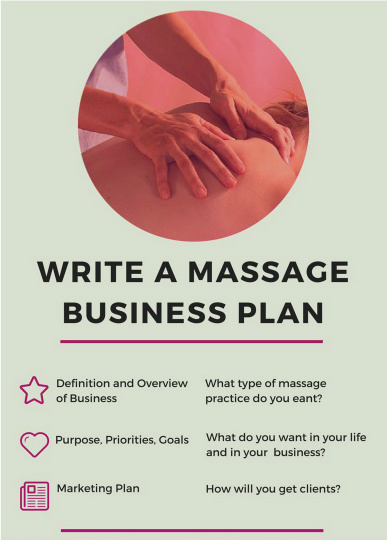- Home
- Massage Business
As an affiliate for Bookshop, Amazon, and other programs, I may earn a small commission for products purchased through links. This doesn't affect the price you pay. Privacy policy and disclosures.
Search this site:
How To Write a Massage Therapy Business Plan To Create a Thriving Practice
Having a successful massage therapy career is more likely if you look ahead to where you want to go. Your first step is to create a massage therapy business plan.

If you think business plans are tedious, look at your business plan as a living guide to get you from where you are to where you want to go. You can change your plan as your practice develops, but without a guide to building your business, you're more likely to become one of the many massage therapists who quit the profession in less than five years.
Massage Therapy Business Plan Sample
Here's a sample massage business plan template with suggested topics. Change or add to this template as needed to suit the type of massage practice your want. Links will take you to an article with more information on a topic.
Business Definition and Overview
What’s your massage experience and education? If you have experience, how will you use it to build your business? If you have no experience, what type of massage practice do you want? Also ask yourself:
- Who is your ideal client? (It’s OK to have more than one, but you cannot be everything to everybody.) For example, do you want to work with people in serious pain or with a serious illness or do you prefer generally healthy people?
- Will you accept insurance?
- Where do you want to work? Your own office? Mobile? Rent space from a chiropractor or other healthcare provider? A spa?
Positioning Statement
How do you want people to see your massage practice? Do you offer
massage therapy to relieve stress and promote well-being and health? Do
you help people who have been in accidents return to pain-free
functioning? Do you offer comforting massage to people with serious
illness?
Services Offered
What types of massage do you offer? Do you offer other services, such as spa treatments?
Philosophy
What’s your approach to massage? Why are you in this profession and what’s important about it? How do you interact with clients?
What’s Your Unique Selling Proposition (USP)?
What makes you and your massage services different from other massage therapists in your area? Differentiating
your practice with a USP for massage makes it
easier to market your services. To start developing your USP, consider the people you most want to reach. Who are your target clients? What are their needs? How does your massage practice meet these needs? Don't worry about alienating some people. You can't be all things to all people. Find your interests and strengths and play them up!
Purpose, Priorities, Goals
What do you want in your life and in your massage business? It’s a good idea to set both one-year goals and three- to five-year goals. You can always change them as your life changes, but it’s important to start by pointing yourself in a specific direction.
Some goals and priorities you might want to set:
- Establishing a marketing plan and setting aside a specified number of hours each week for marketing your business.
- Setting financial goals, including income and how may clients you want to see each week. Setting a budget, tracking your time and money, and regularly reviewing your finances.
- Providing professional and superior massage therapy, including being fully present and offering appropriate modalities for your clients’ needs. Committing to practicing within your scope of knowledge, abilities, and the law. Maintaining client confidentiality.
- Keeping pertinent and complete records and reviewing a client’s file before each session. Asking for client feedback.
- Setting up efficient office systems, including having clear, written business policies, using relevant client forms, and doing an intake interview with each client where you ask clear, open-ended questions without judgement.
- Making plans for continuing education and professional development.
- Inspecting your equipment and products regularly to make sure they are in excellent condition.
- Planning for client education, such as sending a quarterly newsletter to your clients or writing articles for publication.
- Practicing self-care, such as receiving frequent massage, eating healthy, exercising regularly, practicing proper body mechanics, establishing regular working hours, and taking time off to refresh and recharge. Self care is vital to having a long career.
- Having procedures to ensure your personal safety.
Financial Considerations
For the financial section of your massage therapy business plan, look at your startup costs and how you will pay for them. Startup costs are likely to include:
- Initial rent
- Massage equipment — massage table and a portable massage chair
- Supplies such as massage table sheets, oils, and creams
- Office supplies
- Marketing, including building a massage website and business cards
- Massage liability insurance
- Phone/internet setup
What are your ongoing expenses? For example, rent, supplies and phone, marketing costs, continuing education, and licensing.
How much money do you need to bring in each month to live
comfortably? Be realistic. Financial stress is one reason so many
massage therapists quit. Make sure you budget for taxes, including self-employment tax.
If you have trouble dealing with money and numbers, get help from someone who understands the massage business.
Massage Liability Insurance
For professional massage therapists, massage liability insurance is a necessary cost of doing business.
Liability claims against massage therapists are low compared to most other healthcare professions, meaning that insurance rates are also low. A couple of hundred dollars a year is meager amount to pay for the protection you will have if someone files a claim against you.Understanding Insurance Options
When looking at massage business insurance options, it’s important to understand the different types of coverage:
- Massage therapy liability insurance, which could be called massage malpractice insurance, protects you if a client claims your massage caused an injury or other adverse effect.
- General liability insurance (trip and fall insurance) covers you if a client is injured or has property damaged while on the premises of your business.
- Product liability insurance covers bodily injury or damage resulting from the use of a covered product. Make sure your client isn’t allergic to that new oil you want to use!
Liability coverage is expressed with limits that look like this: $2 million per occurrence/$6 million aggregate. This means you are covered up to $2 million for any one claim and up to $6 million total.
Some massage therapy insurance policies also cover things such as lost or stolen equipment. Most policies also have exclusions—make sure you know what they are.
Claims-Made vs. Occurrence Policies
If the insurance is a claims-made policy, you must file a claim during the policy period. If the insurance is an occurrence policy, you can file a claim after the policy period if the incident occurred during the period.Buying Massage Liability Insurance
Two common ways to get insurance are by joining the American Massage Therapy Association (AMTA) or the Associated Bodywork and Massage Professionals (ABMP).
However, liability insurance is available from other sources.
Massage Marketing Plan
A detailed massage marketing plan is an essential part of your massage therapy business plan. Educate yourself about how to market massage, find what you are good at, and make it fun. Here are a few massage marketing tips to get you started:
- Decide on your target market (you can have more than one, but each
gets a different marketing message). The biggest marketing mistake
massage therapists make is lack of focus.
- Find out what your targeted market wants. Medical massage attracts
different clients than spa massage. Pregnant women want something
different in their massages than do professional athletes.
- Put together a marketing message to appeal to your target market.
Think benefits, not features. A benefit is how you help relieve some of the
discomfort of pregnancy or help injuries heal faster. A feature is your
training, what technique you use, or how long you've been in practice.
- Go where your target market is. Athletes are at athletic events and
read sports publications. Pregnant women are at childbirth classes and
read parenting publications.
- Ask for the appointment.
- Ask for referrals.
- Be reliable. Always be on time. Return calls and respond to e-mails promptly.
- Learn about massage marketing techniques, and discover your
marketing style so that you can choose what works for you.
Keep Your Plan Up-to-Date
Now that you have a massage therapy business plan, set aside time once every month or two to review it and assess where you are. Make changes as appropriate.
Treat your business like a client: Take the same approach to your business as you do to treating your clients and you’ll have a happy, healthy practice.
Here's a list of massage therapist business resources to help you run a successful massage practice:
Aromatherapy For Massage Therapists is an online course from massage therapist and aromatherapist Andrea Butje of the Aromahead Institute.
Massage Naturals is an online store where you can buy a variety of massage supplies.
Massage Nerd – lots of information and resources.
Massage Today is a digital magazine.
Sohnen-Moe Associates – a variety of resources for massage therapists.
For massage therapists who want to learn more about spas and spa treatments, the following books are helpful:
- SPA: A Comprehensive Introduction
- Spa Bodywork: A Guide for Massage Therapists
- The Complete Spa Book for Massage Therapists
Buy essential oils from Aromatics International (recommended).
Rocky Mountain Essential Oils.
